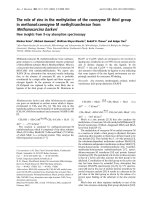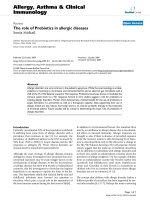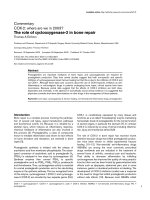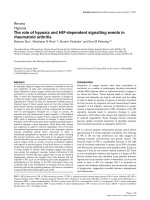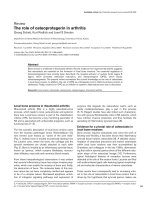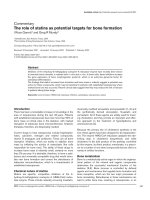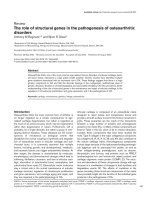Báo cáo y học: " The World Trade Center Attack Helping the helpers: the role of critical incident stress management" potx
Bạn đang xem bản rút gọn của tài liệu. Xem và tải ngay bản đầy đủ của tài liệu tại đây (37.56 KB, 3 trang )
research
commentary
review
reports meeting abstracts
CISD = critical incident stress debriefing; CISM = critical incident stress management; EMS = Emergency Medical Service; PTSD = post-traumatic
stress disorder.
Available online />While the first tasks in disaster management are to secure the
scene, to triage, and to evacuate victims to definitive care, the
disaster plan fails if it stops at the hospital door. It has been
recognized that both disaster victims and workers are at risk
for acute and chronic post-traumatic stress disorder (PTSD). It
has also been acknowledged that treating established PTSD
has only a marginal effect. All this has led to attempts to inter-
vene early so as to prevent, or at least minimize, psychological
morbidity following traumatic events. The underlying premise
for early intervention is to limit the establishment of maladap-
tive and disruptive cognitive or behavioral patterns.
What are critical incident stress debriefing
and critical incident stress management?
Mitchell described, in 1983, a brief, structured, interventional
technique to be used immediately or shortly after a traumatiz-
ing event, and coined the term ‘critical incident stress debrief-
ing’ (CISD) [1]. A critical incident is one that leads to an
unusually powerful stress reaction that overwhelms the per-
son’s ability to adjust emotionally. In 1989, Dyregrov modified
and expanded the technique and called it ‘psychological
debriefing’ [2]. This was designed to take place within a
group setting 48–72 hours after a traumatizing event in an
attempt to assist participants in cognitively and emotionally
processing their experiences.
CISD is now part of a comprehensive spectrum of techniques
called critical incident stress management (CISM), and may
be supplemented by earlier interventions, such as demobiliza-
tion or defusing, or one-on-one encounters. CISD is neither
psychotherapy nor counseling, but is instead designed to
promote emotional health through verbal expression, cathartic
ventilation, normalization of reactions, health education, and
preparation for possible future reactions. The debriefing tech-
nique consists of reviewing the traumatic experience, encour-
aging emotional expression and promoting cognitive
processing [3]. All this is carried out in group sessions, facili-
tated by a mental health professional and a peer of the group
but one that was not involved in the event. The group setting is
preferred as a forum for communication as it helps to re-estab-
lish order and a sense of safety. Participants are invited to
recount their experiences chronologically and to describe the
most terrifying aspects. The facilitators acknowledge the inten-
sity of the experience, but also emphasize the universality of
Review
The World Trade Center Attack
Helping the helpers: the role of critical incident stress management
Jeffrey Hammond* and Jill Brooks
†
*Department of Surgery, Robert Wood Johnson Medical School, New Brunswick, New Jersey, USA
†
Department of Neurology, Robert Wood Johnson Medical School, New Brunswick, New Jersey, USA
Correspondence: Jeffrey Hammond,
Published online: 6 November 2001
Critical Care 2001, 5:315-317
© 2001 BioMed Central Ltd (Print ISSN 1364-8535; Online ISSN 1466-609X)
Abstract
Healthcare and prehospital workers involved in disaster response are susceptible to a variety of stress-
related psychological and physical sequelae. Critical incident stress management, of which critical
incident stress debriefing is a component, can mitigate the response to these stressors. Critical
incident stress debriefing is a peer-driven, therapist-guided, structured, group intervention designed to
accelerate the recovery of personnel. The attack on the World Trade Center, and the impact it may
have on rescue, prehospital, and healthcare workers, should urge us to incorporate critical incident
stress management into disaster management plans.
Keywords critical incident, debriefing, disaster, stress, stress management, post-traumatic stress disorder
Critical Care December 2001 Vol 5 No 6 Hammond and Brooks
their reactions. They also describe reactions that the group
should expect and teach coping strategies, including the
importance of resuming normal activities and the value of con-
tinued dialog with friends and family.
Reserved for dramatic events, CISD does not focus on work-
related complaints because these are the province of an
employee assistance plan. CISD is also not intended as a
‘one shot’ remedy. It is part of the systematic approach to
CISM that includes pre-incident stress education programs,
on-scene support, peer support programs, follow up services,
and referral procedures [4].
Do we need CISM?
There is no doubt that working in the emergency services
exposes workers to numerous stressors. Critical incidents
include deaths in the line of duty, coworkers committing
suicide, significant events involving children, incidents
involving relatives or knowing the victims, excessive media
interest, and disaster or mass casualty events [5]. All of
these can be applied to the attack on the World Trade
Center. One of the most difficult aspects of the emergency
services, including disaster work, is the exposure to sudden,
violent death, including that of children, and the exposure to
dead bodies and body parts. The risk to personal safety,
especially in an age of biohazards, adds to the stressors of
service delivery.
These stressors are often cited as reasons for increased
rates of divorce, substance abuse, and loss of personnel
through attrition. The symptoms of critical incident stress are
varied [6]. Common signs and symptoms of excessive stress
include cognitive, emotional, behavioral and physical aspects,
and these are described in Table 1.
The notion of ‘victim’, however, is not generally applied to
rescue, medical, or support staff associated with disaster
medicine. Nevertheless, several studies suggest that person-
nel involved in disaster medicine, especially those involved
with the recovery and identification of human remains, are at
particular risk for the development of PTSD.
For instance, a survey of 459 Australian firefighters identified
that 32% self-reported psychological disturbances 4 months
after they combated a disastrous bush conflagration. After 29
months, 18% reported that recurring imagery continued to
interfere with their lives [7]. In a different study, nearly one-
half of 285 emergency workers surveyed 1 year after two
major bus crashes reported stress-related symptoms, and
13% felt they would probably never recover [8].
A study of 116 US soldiers handling remains from Operation
Desert Storm, employing the Impact of Event Scale [9], identi-
fied a significant association of intrusive and avoidance behav-
ior 3–5 months after their return home that was directly related
to the number of bodies handled in a ‘dose response’ fashion
[10]. Intrusive and avoidance symptoms of PTSD were also
present, at a high clinical threshold, among 16% of 54 Navy
personnel involved in mortuary duties following the 1989 turret
explosion on the USS Iowa [11]. The baseline rate of PTSD in
the general population is held to be 1.9% [12].
But does CISM work?
During the past two decades, CISD has been successfully
used with emergency workers and prehospital providers such
as the Emergency Medical Service (EMS), police and fire-
rescue, as well as with soldiers, prisoners of war, hostages,
and disaster workers. Most evidence is anecdotal, and few
controlled or randomized studies exist. However, multiple
doctoral dissertations indicate positive results from CISM,
including CISD [4]. Police officers and firefighters receiving
as little as a 1.5-hour debriefing within 24 hours of an incident
exhibited statistically significant less depression, anger, and
stress-related symptoms at 3 months than did nondebriefed
subjects. EMS personnel receiving CISD after the 1992 Los
Angeles riots also exhibited significantly less stress than non-
debriefed EMS staff.
A decrease in Impact of Event Scale scores among rescue
workers in Hawaii after Hurricane Iniki in 1992 included both
clinical and administrative workers [13]. Eighty-eight percent
of 219 Emergency Department nurses felt that the CISD
process was helpful to them after a tragedy [14]. Anxiety
Table 1
Common signs and symptoms of excessive stress
Cognitive Emotional Behavioral Physical
Confusion Anger Changes in eating Tachycardia
Disorientation Grief Sleep disorders Tachypnea
Attention deficits Depression Decreased personal hygiene Dizzy spells
Difficulty making decisions Hopelessness Withdrawal from others Hypertension
Memory loss Helplessness Prolonged silences Excessive sweating
Nightmares Feeling overwhelmed Panic attacks Dazed or numb appearance
research
commentary
review
reports meeting abstracts
scores from 35 British police officers 3 months and 3 years
after retrieval and identification of remains from the 1988 Piper
Alpha oil rig disaster were significantly lower in the interven-
tion group compared with controls [15]. These individuals
received CISM in the form of pre-event orientation, nightly
debriefings, and the pairing of experienced with inexperienced
personnel. Because they had taken part in an occupational
survey prior to the disaster, it was possible to determine that
anxiety levels returned to near baseline in the treatment group.
Studies casting doubt on the efficacy of CISD or psychologi-
cal debriefing are often flawed. For instance, debriefings may
have been performed improperly, they may have been unstruc-
tured or delayed, or the outcome measures used were unclear
[16]. Outcomes other than PTSD may be important to investi-
gate. Using the CAGE measure of problem drinking [17], 25%
of 106 British servicemen returning from Bosnia had scores
consistent with alcohol misuse. At 12 months after a single
CISD debriefing, the intervention group had a 6.3% rate of
alcohol misuse versus 30.4% for those randomized to the
nondebriefing arm. A 1999 meta-analysis of five studies of the
‘Mitchell model’ of CISD, incorporating 341 adult subjects,
demonstrated a large effect size supporting the power of
CISD to mitigate the symptoms of psychological distress [18].
CISM as part of a disaster plan
An infrastructure for CISD should be incorporated into hospi-
tal and regional disaster plans, including provisions for volun-
teer and inhospital workers. This should also include a group
not previously studied: 911 dispatchers. The call volume to
New Jersey 911 dispatchers increased 66% during 08:00 to
14:00 on the day of the World Trade Center attack. Unlike
the usual, short duration calls reporting an accident, these
calls were often from individuals inside the World Trade
Center itself. Often long, final conversations from anguished
trapped victims asking what to do, these were calls for which
the dispatchers were not trained. Some of the dispatchers
have not yet returned to work 1 month later (New Jersey EMS
Council, personal communication, 2001).
Adequately trained individuals must provide CISD. Not only
are positive effects more probable, but also the chance of
inadvertent harm is reduced after CISD. Mistakes in providing
CISD as part of a disaster response include failure to have an
adequate number of trained mental health professionals, mis-
understanding the CISM process, not having a CISD team
strategy, attempting to turn CISD into psychotherapy, and
breaking confidentiality. A peer is always required for emer-
gency services, hospital-based personnel, military, and disas-
ter worker debriefings.
Finally, it is important to recognize the risks associated with
CISD [19]. The CISD team members may in fact become
secondary victims. Adequate ‘down time’ between debrief-
ings, and defusings or debriefings for team members, will
avoid stress reactions among the helpers of the helpers.
JH is section chief for trauma and surgical critical care at Robert Wood
Johnson Medical School. He serves as Chairman of the New Jersey
chapter of the American College of Surgeons Committee on Trauma.
He was actively involved in the 1980 Miami (Florida) riots and numer-
ous hurricanes. He is founder and medical director for CISM Team
Orion, which was activated in support of the WTC recovery.
JB is associate professor of neurology specializing in neuropsychology.
She is Co-director of CISM Team Orion and was active as a group
facilitator for police, EMS, and national guardsmen after the WTC
attack, and as an advisor to the state CISM network.
Competing interests
None declared.
Acknowledgement
This article, and the series it is part of, is dedicated to the first respon-
ders – fire, police and medical personnel – who attended the World
Trade Center disaster of 11 September 2001. They did not hesitate to
place themselves in harm's way to rescue the innocent, and without
their efforts many more would have perished. They will not be forgotten.
References
1. Mitchell JT: When disaster strikes … the critical incident
debriefing process. J Emergency Med Services 1983, 8:36-39.
2. Dyregrov A: Caring for helpers in disaster situations: psycho-
logical debriefing. Disaster Manage 1989, 2:25-30.
3. Kaplan Z, Iancu I, Bodnar E: A review of psychological debrief-
ing after extreme stress. Psychiatr Services 2001, 52:824-827.
4. Mitchel JT, Everly G Jr: The scientific evidence for critical inci-
dent stress management. J Emergency Med Services 1997,
January:86-92.
5. Mitchell JT: Development and functions of a critical incident
stress debriefing team. J Emergency Med Services 1988,
December:42-46.
6. Linton JC, Kommer MJ, Webb CH: Helping the helpers: The
development of a critical incident stress management team
through university/community cooperation. Ann Emergency
Med 1993, 22:663-668.
7. McFarlane AC: Long-term psychiatric morbidity after a natural
disaster. Med J Aust 1986, 145:561-563.
8. Raphael B, Meldrum L, McFarlane AC: Does debriefing after
psychological trauma work? Br Med J 1995, 310:1479-1480.
9. Horowitz MJ, Wilner N, Alvarez W: Impact of Event Scale: a
measure of subjective stress. Psychosom Med 1979, 41:209-
218.
10. McCarroll JE, Ursano RJ, Fullerton CS: Symptoms of posttrau-
matic stress disorder following recovery of war dead. Am J
Psychiatry 1993, 150:1875-1877.
11. Ursano RJ, Fullerton C, Tzu-Cheg K, Bhartiya VR: Longitudinal
assessment of posttraumatic stress disorder and depression
after exposure to traumatic death. J Nervous Mental Disorder
1995, 183:36-42.
12. Helzer JE, Robins LN, McEvoy L: Post-traumatic stress disorder
in the general population. N Engl J Med 1987, 317:1630-1634.
13. Chemtob C, Tomas S, Law W, Cremniter D: Postdisaster
psychological intervention: A field study of the impact of debrief-
ing on psychological distress. Am J Psychiatr 1997, 154:415-417.
14. Burns C, Harm I: Emergency nurses’ perceptions of critical
incidents and stress debriefing. J Emergency Nursing 1993,
19:431-436.
15. Alexander DA: Stress among police body handlers: A long
term follow-up. Br J Psychiatry 1993, 163:806-808.
16. Deahl M, Srinivasan M, Jones N, et al.: Preventing psychological
trauma in soldiers: The role of operational stress training and
psychological debriefing. Br J Med Psychol 2000, 73:77-85.
17. Mayfield D, McLeod G, Hall P: The CAGE Questionnaire: valida-
tion of a new alcoholism screening instrument. Am J Psychiatr
1974, 131:1121-1130.
18. Everly GS Jr, Boyle SH: Critical incident stress debriefing (CISD):
A meta-analysis. Int J Emergency Mental Health 1999, 3:165-168.
19. Bisson JI, Deahl MP: Psychological debriefing and prevention
of post-traumatic stress: More research is needed. Br J
Psychiatry 1994, 165:717-720.
Available online />


